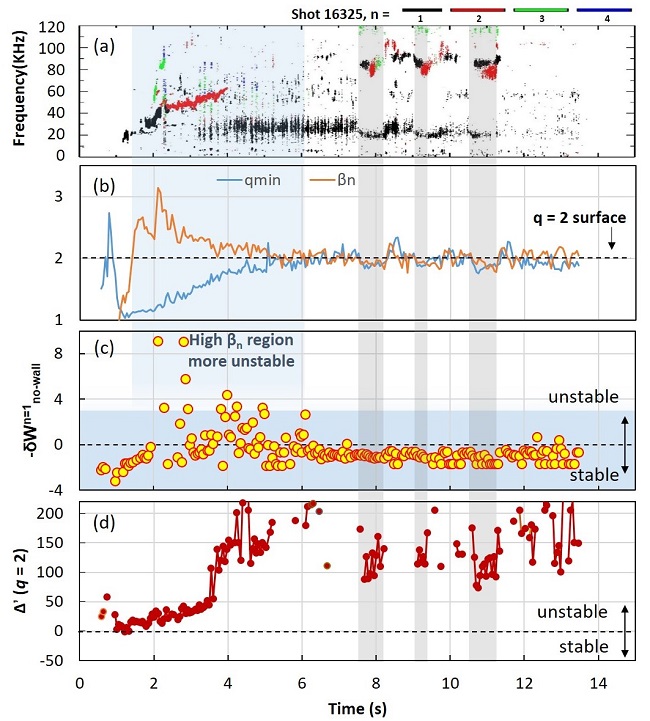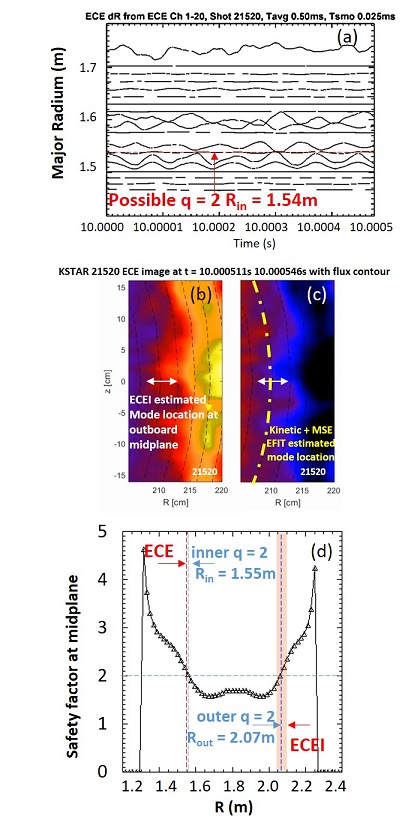Speaker
Description
Disruption prediction and avoidance is a high-priority challenge for tokamaks to sustain long pulse and high performance plasmas that are critical for ITER and next-step devices for fusion generation. Disruption-free, continuous operation of high performance plasmas over long pulse is a main goal of modern superconducting tokamak devices such as the Korea Superconducting Tokamak Advanced Research (KSTAR) facility. Stability analyses including ideal global magnetohydrodynamic (MHD) and resistive MHD instabilities have been developed to provide input to plasma disruption forecasting analysis. Existing research has shown that analyses spanning only limited time periods have proved difficult to create reliable time evolution of stability analysis with continuous and clear predictions using experimental data. Equilibrium reconstruction noise and apparent inconsistencies with experimental diagnostic data or modeling yielding poor convergence need to be resolved for successful model validation. High fidelity kinetic equilibrium reconstructions are an essential requirement for accurate determination of the plasma stability and disruption prediction analyses to support the goal of continuous, disruption-free operation.
In this work, equilibria with the required accuracy and fidelity are produced as input for a suite of stability analysis, including ideal MHD stability (codes PEST and DCON) (1,2), resistive MHD (resistive DCON) (3), and kinetic MHD (MISK) (4), which can then be used to determine correlations with experimental plasma stability. Compilations of such analyses can produce multivariate models for marginal stability to modes that can either directly or indirectly cause plasma disruption (5). Such analyses comprise an important part of the disruption event characterization and forecasting (DECAF) framework presently expanding in capability to characterize and forecast plasma disruptions in tokamaks (6).
Unlike analysis that uses only external magnetic measurements (magnetics-only), kinetic equilibrium reconstructions provide measurement constraints internal to the plasma including the plasma temperature and density profiles. The present kinetic equilibrium reconstructions include Thomson scattering (TS) data, charge exchange spectroscopy (CES) data, and allowance for fast particle pressure in addition to external magnetics and shaping field current data, and inclusion of vacuum vessel and passive plate currents following an approach used successfully in NSTX. In addition, up to 25 channels of motional Stark effect data are used to constrain the local magnetic field pitch angle to produce reliable evaluation of the q profile.
The present low-convergence error level (from $10^{-10}$ to $10^{-13}$ maximum Grad-Shafranov error) of the equilibria can provide clear and continuous trends in DCON and resistive DCON shown in Fig. 1, except when $\it{q_{min}}\geq $ 2 (no 2/1 surface precludes the mode). The analysis of KSTAR kinetic equilibria shows unstable ideal stability (above the no-wall limit) during the high $\beta_N$ period as shown in (c) and (b). The corresponding experimental plasmas do not show unstable global RWM instabilities indicating that kinetic effects need be added to the analysis to accurately determine the plasma stability. Although the ideal no-wall limit stability analysis is not by itself sufficient to predict disruption, the clear, full time evolution still provides important plasma stability information and can be used to produce reduced stability forecasting models in DECAF analysis for the reduced kinetic stability model in the code. The resistive DCON calculation (d) indicates an unstable tearing mode in the whole plasma evolution, but there were not any strong tearing modes observed in the experiment. The magnetic spectrogram (a) shows evidence of n = 2 mode activity when $\it{q_{min}}$ is below but close to $\it{q}$ = 2.
Kinetic equilibria with MSE have been improved to sufficiently high accuracy and validation compared to experiment by 1) optimizing the basis functions for the plasma current profile, 2) compensating magnetics from 3D fields produced by resonant magnetic perturbation coils, and 3) evaluating MSE error with systematic and statistical components. Moreover, the q profile is validated by electron cyclotron emission (ECE) radiometry and ECE imaging, as shown in Fig. 2. The ECE radiometers in (a) show 1D radial electron temperature $\it{T_e}$ profiles, which indicate the possible $\it{q}$ = 2 surface location at the inboard midplane. Meanwhile the 2D ECE imaging (ECEI) in (b) and (c) detects the local electron temperature fluctuations and provides a magnetic island position, evaluating the outboard $\it{q}$ = 2 surface at the midplane. The $\it{q}$ profile from kinetic equilibrium reconstructions with MSE (Fig. 2 (d), KSTAR 21520) compares well to the rational surface positions from the ECE and ECEI results.


*Supported by US DOE grant DE-SC0016614
(1) Grimm R. C. et al 1976 Methods in Comput. Phys. 16 253
(2) Glasser A. H. and Chance M. S. 1997 Bull. Am. Phys. Spc. 42 1848
(3) Glasser A. H. et al 2016 Phys. Plasmas. 23 112506
(4) Hu B. et al 2005 Phys. Plasmas 12 057301
(5) J.W. Berkery, S.A. Sabbagh, R.E. Bell, et al. 2017 Phys. Plasmas 24 056103
(6) S.A. Sabbagh, J.W. Berkery, Y.S. Park, et al. to be submitted 2020
| Affiliation | Columbia University |
|---|---|
| Country or International Organization | United States |
